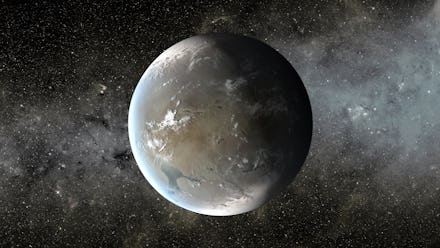Kepler-62f: Everything You Need to Know About the Distant Planet That Could Sustain Life

A planet 1,200 light years away is one of the best candidates for life that we've ever discovered.
It's called Kepler-62f, and it's so far away that we can't tell many details about it. But a team of astronomers just published a study outlining tons of scenarios in which the planet could support life.
About Kepler-62f
It's about 40% larger than Earth, which means it falls within the size range of rocky, ocean-filled worlds. In fact, previous research suggests it's probably a very watery world.
It's one of five planets orbiting a star that's slightly cooler and dimmer than our sun. It takes about 267 days to circle its star. And just like Earth, it sits in the habitable zone around its star.
Earth's atmosphere is less than 1% carbon dioxide. But Kepler-62f is farther away from its host star than the Earth is from the sun, so it would need a lot more carbon dioxide in its atmosphere to keep it warm enough for liquid water to exist on the surface.
Why Kepler-62f might be able to sustain life
When astronomers ran simulations of what Kepler-62f's atmospheric conditions and orbital pattern might be, they found a wide range of scenarios that would make the planet habitable.
"We found there are multiple atmospheric compositions that allow it to be warm enough to have surface liquid water," Aomawa Shields, lead author of the study and a National Science Foundation fellow at UCLA, told Phys.org. "This makes it a strong candidate for a habitable planet."
What's more, even if the planet doesn't have much carbon dioxide for warmth, it could still have habitable conditions part of the year.
"But if it doesn't have a mechanism to generate lots of carbon dioxide in its atmosphere to keep temperatures warm, and all it had was an Earth-like amount of carbon dioxide, certain orbital configurations could allow Kepler-62f's surface temperatures to temporarily get above freezing during a portion of its year," Shields said. "And this might help melt ice sheets formed at other times in the planet's orbit."
Kepler-62f is one of about a dozen small planets in the habitable zone of its star, but there's likely many more out there.